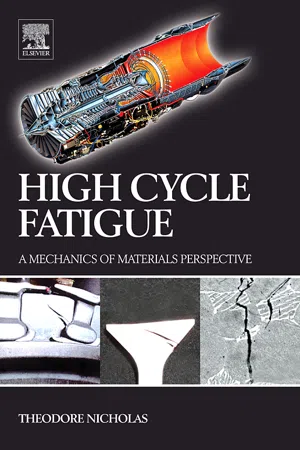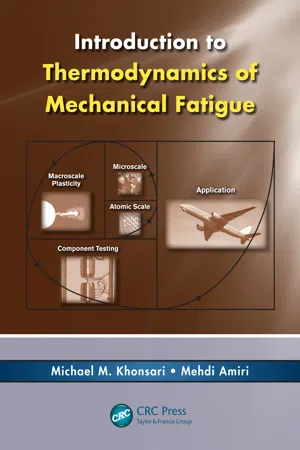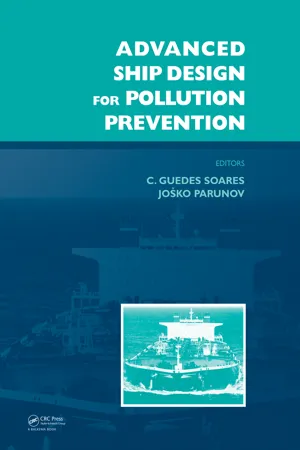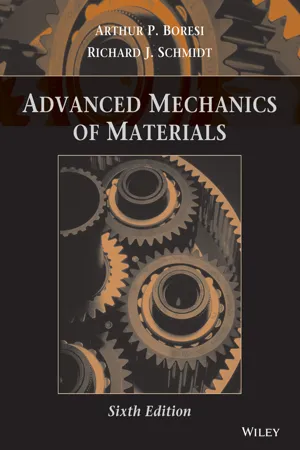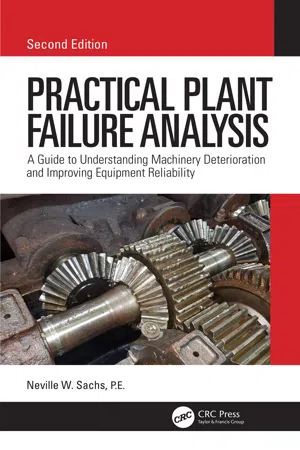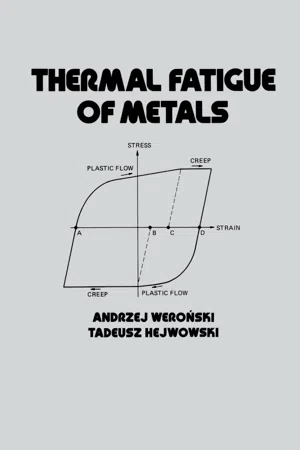Technology & Engineering
High Cycle Fatigue
High cycle fatigue refers to the process of material failure due to repeated stress or strain at relatively high frequencies. This type of fatigue typically occurs in materials subjected to cyclic loading, such as rotating machinery components or structural elements under dynamic loads. It is characterized by the accumulation of microcracks and eventual failure, often leading to catastrophic consequences if not properly managed.
Written by Perlego with AI-assistance
Related key terms
1 of 5
10 Key excerpts on "High Cycle Fatigue"
- eBook - ePub
Metal Failures
Mechanisms, Analysis, Prevention
- Arthur J. McEvily, Jirapong Kasivitamnuay(Authors)
- 2013(Publication Date)
- Wiley-Interscience(Publisher)
For example, a plate of steel that contains a hole of 1 mm (0.04 in.) diameter will have a higher fatigue strength than a plate containing a hole of 1 cm (0.4 in.) diameter, despite the fact that in both cases the stress concentration factor is 3.0. Materials in engineering usage are often cyclically loaded in corrosive environments that degrade the fatigue properties. For example, ship propellers and drilling platforms operate in sea water, which accelerates both the crack initiation process and the crack growth process. The term corrosion fatigue is used to describe the combined action of cyclic loading and corrosion. A related form of fatigue is known as fretting corrosion fatigue, with fretting being due to the relative motion of surfaces under pressure—for example, between a rivet head and the clamped sheet metal in an aircraft structure. Aircraft turbine blades experience huge numbers of vibratory cycles during their lifetimes; for this reason, there is interest in fatigue at ultra-high cyclic lifetimes, such as cycles. In some of these ultra-high fatigue lifetime studies, it has been observed that for certain steels at high numbers of cycles, a drop in fatigue resistance can occur due to the growth of subsurface fatigue cracks. In assessing the fatigue performance of turbine blades, the possibility of foreign object damage (FOD) due to the ingestion of hard particles into an aircraft turbine engine must be taken into account. The effect of bird strikes on turbine blade performance is another consideration, one that, until recently, precluded the use of composite materials as first-stage turbine blades because of their low resistance to bird-impact damage. Much of the early testing in fatigue was carried out under fully reversed loading, where the mean stress was zero, as in the case of a railroad car axle. However, components are often cycled about a mean stress other than zero, and the designations and are used to describe such loading conditions - eBook - PDF
High Cycle Fatigue
A Mechanics of Materials Perspective
- Theodore Nicholas(Author)
- 2006(Publication Date)
- Elsevier Science(Publisher)
The extensive review by Schütz is recommended reading for anyone with an interest in the history of the subject. 1.2. WHAT IS High Cycle Fatigue? A number of years ago I was preparing to give a briefing to some high-level managers at Air Force headquarters. It was for the purpose of informing them of the program that was being put together to address issues related to HCF in turbine engines, particularly with respect to material behavior. Since this was a high-level briefing, the charts had to be reviewed by the appropriate staff members to make sure it had the proper length, format, and content. My briefing charts were all found to be satisfactory, with no changes, except for one additional chart that they felt I needed at the beginning. I was asked to define HCF. I was partially stumped because I had never seen a good formal definition of HCF. I don’t remember what I put together for the briefing, but it centered around the premise that HCF involved longer lives than low cycle fatigue (LCF), which I also had to explain, and it generally involved high frequencies in excess of around 1000 Hz (cycles per second, which I also had to explain!). Perhaps a better definition would be a fatigue condition where the number of cycles between possible inspections is too large to be able to do anything about it in a practical sense. I avoided a popular definition where purely elastic behavior is associated with HCF while LCF involves cyclic plasticity. What if someone asked “How much plasticity?” LCF is usually conducted under strain-controlled conditions while HCF generally involves load control, but this also is a rather vague way to define the difference between the two. There is no formal definition in my mind, but HCF generally involves high frequencies, low amplitudes, nominally elastic cyclic behavior, and large numbers of cycles. - Michael M. Khonsari, Mehdi Amiri(Authors)
- 2012(Publication Date)
- CRC Press(Publisher)
According to Load Operating Condition Low-cycle Torsion Stress-State Low-Cycle High-Cycle Variable Amplitude Environmental Condition Load Load Time Air Corrosion fatigue Cycle Axial Multiaxial 10 3 10 3 10 6 10 6 Cycles Description Intermediate-cycle High-cycle Bending FIGURE 4.2 An overview of the parameters that influence the fatigue life. K14850_Book.indb 51 06/08/12 5:58 P 52 Introduction to Thermodynamics of Mechanical Fatigue Bannantine, Comer, and Handrock (1997), for most steels with ultimate strength , S ut < 1380 MPa, the following relationship between S ut and S e holds S e = 0.5 S ut for S ut < 1380 MPa (4.1) It is also widely accepted that fatigue strength for a life of 10 3 cycles can be estimated as 90% of the ultimate strength as shown in Figure 4.3. Conventionally, fatigue lives greater than 10 6 cycles are considered to be infinite. Although it is assumed that for stresses below endurance limit, material never fails, experi-mental observations show that even for very high-cycle fatigue, with stress far below the endurance limit, fatigue failure can, in fact, occur (Bathias and Paris 2004; Lukas and Kunz 1999; Nishijima and Kanazawa 1999; Mughrabi 1999; Szczepanski et al. 2008). For example, Mughrabi (1999) describes the failure mechanism in very high-cycle fatigue pro-cesses by bringing into play the role of cyclic slip irreversibility associated with microplas-tic strains and showing that they accumulate over time and eventually lead to failure. The reader interested in detailed discussion on failure mechanism in high- and very-high-cycle fatigue is referred to Bathias and Paris (2004). Fatigue tests are generally expensive and time consuming as they may take several days of continuous testing especially for very-high-cycle fatigue. For example, for a single speci-men at 10 Hz loading frequency, nearly 27 hrs would be required to amass 10 6 cycles. For a higher number of cycles, experiments become quite costly to operate.- Carlos Guedes Soares, Joško Parunov(Authors)
- 2010(Publication Date)
- CRC Press(Publisher)
wave loads, so that after certain amount of time structural failure occurs. This may lead to problems that vary in scale from unwanted and costly repairs to a large crack propagation that endangers entire structure. Despite of significant scientific effort involved in understanding fatigue phenomena fatigue failure is still a significant source of problems. Oceangoing ships are particularly prone to fatigue due to several reasons occurring simulta-neously: they operate in the corrosive environment for 20 years or more, they are exposed to various loads and at times sail in harsh environment, ship structure contains very big number of common or special types of structural details, the length of the welds is measured in kilometers etc. Two basic types of material fatigue may be dis-tinguished: first, High Cycle Fatigue (HCF) that occurs due to a large number of medium strength loads and second, low cycle fatigue (LCF) that occurs due to a small number of high strength loads. In shipbuilding industry HCF is commonly investigated using statistical and probabilistic methods in combination with hydrodynamic and structural analysis, either by simplified method or by direct calculations. Classification societies Rules are followed whenever possible. Fracture analysis of crack growth is usually not of main concern as cracks appear on various locations (structural details), so statistic and probabilistic approach bet- 164 such as wave loads, vibrations, thermal stresses etc. Among these, wave loads are considered to be the main cause of High Cycle Fatigue for structural details directly exposed to wave loads (e.g. side shell longitudinals), but also for a number of other structural details that “feel” the wave induced hull structure deformation. Structural details life-span is commonly esti-mated by fatigue damage summation based on S-N (Wöhler) curves. S-N curves are constructed using the results of a number of cyclic load tests until the structural detail failure.- eBook - PDF
- Arthur P. Boresi, Richard J. Schmidt(Authors)
- 2019(Publication Date)
- Wiley(Publisher)
CHAPTER 16 FATIGUE: PROGRESSIVE FRACTURE Fatigue has been defined as “the progressive localized permanent structural change that occurs in a material subjected to repeated or fluctuating strains at stresses having a maximum value less than the tensile strength of the material” (ASM, 1975). As noted in Chapter 15, failures occur in many mechan- ical systems. It has been estimated that between 50% and 90% of these failures are due to fatigue (Fuchs and Stephens, 1980). Failures caused by fatigue cul- minate in cracks or fracture after a sufficient number of fluctuations of load. Fracture of a structural member as the result of repeated cycles of load or fluctuating loads is commonly referred to as a fatigue failure or fatigue fracture. The correspond- ing number of load cycles or the time during which the member is subjected to these loads before fracture occurs is referred to as the fatigue life of the member. The fatigue life of a member is affected by many factors (ASM, 1975). For example, it is affected by 1. the type of load (uniaxial, bending, torsion), 2. the nature of the load–displacement curve (linear, nonlinear), 3. the frequency of load repetitions or cycling, 4. the load his- tory [cyclic load with constant or variable amplitude, random load, etc. (Gauthier and Petrequin, 1989; Buxbaum et. al, 1991)], 5. the size of the member, 6. the material flaws, 7. the manufacturing method (surface roughness, notches), 8. the operating temperatures (high temperature that results in creep, low temperature that results in brittleness), and 9. the environmental operating conditions (corrosion, see Clarke and Gordon, 1973). In practice, accurate estimates of fatigue life are difficult to obtain, because for many materials, small changes in these conditions may strongly affect fatigue life. The designer may wish to rely on testing of full-scale members under in-service conditions. However, testing of full-scale members is time consuming and costly. - eBook - ePub
Practical Plant Failure Analysis
A Guide to Understanding Machinery Deterioration and Improving Equipment Reliability, Second Edition
- P.E. Sachs(Author)
- 2019(Publication Date)
- CRC Press(Publisher)
Fatigue failures are caused by cyclical loads. There aren’t any formal definitions for the fatigue failures categories, but three general classifications are:- 1. High Cycle Fatigue (HCF) − Where the failure takes more than 10,000 cycles. These probably account for more than 90% of all fatigue failures. They are more common than either of the other categories and this chapter will cover them in detail. Most High Cycle Fatigue failures take more than 100,000 cycles and some may take hundreds of million cycles from the initial force application to the final failure.
- 2. Low cycle fatigue (LCF) − When the failure takes fewer than 10,000 but more than about 25 cycles from the initial application of the force to final failure, it is considered a low cycle fatigue failure. They are generally not very common in industrial equipment and, referring to the S-N curve in Figure 5.1 , one can see they involve significantly higher stresses than high cycle failures.
- 3. Very low cycle fatigue (VLC) − One interesting point about low and High Cycle Fatigue failures is that, after the part fractures and the pieces are examined, they show no visible plastic deformation. (There may be some deformation of the last thread on a failed bolt but there is no visible deformation of the body of the part.) However, VLC failures:
- a. Take only a few stress applications, typically less than 10, from initiation to final failure.
- b. Show some small visible deformation in ductile materials.
- c. Indicate that the applied force was only slightly less than what would have caused an overload failure.
- d. Are not very common in industrial equipment but are seen more often than low cycle fatigue examples.
Figure 5.1 A Stress-Number of cycles (S–N) curve showing the generally accepted ranges of fatigue stress cycles.To the best of my knowledge, fatigue failures cannot occur from pure compressive stresses. For fatigue to happen, the part has to undergo periodic tensile stress then relaxation, then stress, then relaxation, and this cycle has - eBook - ePub
Fatigue of Materials and Structures
Fundamentals
- Claude Bathias, André Pineau, Claude Bathias, André Pineau(Authors)
- 2013(Publication Date)
- Wiley-ISTE(Publisher)
Chapter 4Low-cycle Fatigue 1
4.1. Introduction
4.1.1. Application domain of low cycle plastic fatigue
As we expect from its name, low cycle fatigue (LCF) has two fundamental aspects: – a significant plastic deformation occurs in each cycle, i.e. plasticity; – low cycle phenomenon, in that the materials have a finite endurance for this type of loading. Analysis of material behavior under this type of loading is quite common.4.1.1.1. BackgroundIndeed, if the first studies on the role of plastic deformation on fatigue endurance go back to the early 20th century: Bauschinger (1886) to Bairstow (1909), we have to wait until 1948 for the first strain-controlled tests to be carried out (Liu, Lynch and Ripling) and 1952–1953 for the formulae relating endurance to strain amplitude to be proposed (Manson and Coffin [COF 54, MAN 52]). Since then, studies on fatigue have been rapidly multiplied and their importance has been emphasized.The interest in the studies related to low cycle fatigue lies mainly in two fields: – application to the size and design of components in aeronautics, energy production, etc., which can be performed using advanced calculation methods;– the use of LCF results allows us to analyze the behavior of the materials in greater detail and to better understand the complex mechanical and metallurgical phenomena (strain concentration, crack propagation, work-hardening, work-softening, etc.).4.1.1.2. Low-cycle fatigue in structural analysisIndustrial devices are calculated in such a way that the materials in the main structures are not loaded within the plastic domain under normal operating conditions. “Primary” stresses are those that depend mainly on imposed forces and do not disappear under plastic deformation. “Secondary” stresses are those that are mainly due to imposed displacements and relax under a limited plastic deformation. If primary stresses are kept strictly below some fraction of the elastic limit of the materials, “secondary” stresses can be slightly higher than the elastic limit. - eBook - PDF
- John Tien(Author)
- 2012(Publication Date)
- Academic Press(Publisher)
The value of such an exercise lies, hopefully, in developing a capacity for wider application of the principles. At a symposium on the achieve-ment of high fatigue resistance held in 1969 (ASTM STP 467), many useful points emerged. However, since then a number of advances have been made which this author believes permits more secure identifica-tion of the guidelines for alloy design. This chapter, therefore, empha-sizes the most recent work, and is confined to conventional alloys. Fatigue behavior in composites is discussed in Chapter III. 178 Campbell Laird II. CYCLIC STRESS-STRAIN RESPONSE A. Pure Metals 1. Behavior of Polycrystalline Metals at High Strains In line with the aim of avoiding a catalogic approach, only the main phenomena of cyclic response with their relevance to design are dealt with in this chapter. Thus, of the many experimental methods used to investigate the changes in flow stress produced by cycling, the method of plastic strain amplitude control will be selected for illustration. In this method, the peak stress required to enforce a constant cyclic plastic strain (tension-compression testing) is observed as the measure of hardening. The general response of both cold-worked and annealed metals to such a strain is shown schematically by the hysteresis loops in Fig. 1. Cold-worked metals usually soften with increasing cycles, whereas annealed metals usually harden. Plots of such stress values versus the cumulative plastic strain (or cycles, or reversals—defined as occurring whenever the straining direction is changed, and of especial value in variable-amplitude loading, where cycles are difficult to define) expe-rienced by a specimen are termed cyclic strain softening or harden-ing curves, as the case may be. These plots show that the metal hardens ( b ) Fig. 1. Schematic of cyclic stress-strain response of annealed and cold-worked metals, (a) Control condition; (b) hysteresis loops; (c) cyclic strain softening and hardening curves. - eBook - PDF
- Andrzej Weronski(Author)
- 1991(Publication Date)
- CRC Press(Publisher)
Properties of Metals and Thermal Fatigue 183 consistent with reconditioning. Of course, for vital components, whatever the criterion, examination for cracks must be exceptionally thorough and all of the test specifications rigorously observed. In general, the resistance of a material to thermal fatigue, expressed by the number of thermal cycles, N, to the appearance of the fatigue sign chosen as a criterion, can be written as (Weronski, 1985) N= f ( A , B, C) where A = set of values describing the properties of the material and test piece B = set of values characterizing the thermal environment C = correction factor relating laboratory tests to design and operation Set A describes the chemical composition and microstructure of the specimen, its mechanical and physicochemical properties, its geometric shape, the influence of stress raisers, and the state of its surface. Set B describes the temperature range of the cycle, the rate of change of temperature during heating and cooling, the duration of the cycles, and the nature of the surrounding media. In principle the A values are known or determinable in the laboratory; the B values, by the application; and those of C, by the safety factor desired and which takes account of the scale of the laboratory tests, the extent to which they have reproduced the industrial environment, the size and shape of the component, and experience. These factors influence the result to different degrees. The most important single factor is the chemical composition of the material. If this is unsuitable, treatment aimed at improving the microstructure and protecting the surface will be of little help. The majority of published works relating chemical composition to thermal fatigue performance concern two groups of steels: high-alloy austenitic steels and low-alloy steels. - eBook - ePub
- J M Hodgkinson(Author)
- 2000(Publication Date)
- Woodhead Publishing(Publisher)
11Fatigue*
P.T. Curtis11.1 Introduction
Since the early 1980s the reduction of strength and the subsequent failure of materials subjected to cyclic loading has been addressed as one of the most fundamental problems of engineering materials. A satisfactory description of fatigue of materials, based on first principles, has not yet been achieved. Metallic materials, for instance, which are ductile in nature under normal operating conditions, are known to fail in a brittle manner when they are subjected to repeated loading. Because composite materials are regarded as having good fatigue resistance, they are in fact destined to be used in applications, such as in aircraft or other vehicles, in which the degradation of strength and life expectancy by fatigue processes is most likely.In general, the number of cycles to failure depends on a number of variables such as stress levels, stress state, mode of cycling, process history, material composition and environmental conditions. However, composites are, by nature, inhomogeneous and frequently anisotropic. The fatigue processes which reduce strength in these materials are generally very complex, involving the accumulation of many damage modes.This chapter explores the philosophy behind the development of methods for the fatigue testing of polymer composite materials. Methods for performing tests in the major loading regimes will be described, although in many cases there are no formal standards for fatigue testing of these materials. This is partly because of the difficulty in performing fatigue tests on polymer composites but also because it is only recently that standards have been developed for static testing, described in the other chapters of this book. As well as describing test methodology, consideration is given to the types (and indeed the suitability) of mechanical testing machines for measuring fatigue properties of polymer composites. In addition, some of the problems and pitfalls associated with fatigue testing are described and techniques for avoiding, or minimising, their effects are discussed. Ways in which fatigue data are analysed and presented for polymer composites are discussed, so that it can be of most benefit.
Index pages curate the most relevant extracts from our library of academic textbooks. They’ve been created using an in-house natural language model (NLM), each adding context and meaning to key research topics.

